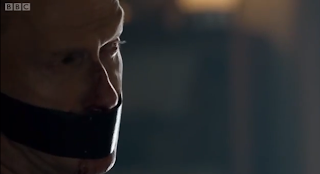Here, we have an extreme close-up to show the details of the object the camera is focusing on at the moment. It's so close it became a macro shot, blurring out the background to avoid distractions.
This shot is a combination of close-up/mid technique, showing more than a close-up can but less than the mid-shot. This way it shows the character's emotions, in this case Sherlock's curious about the blood drop on the wooden planks on the wall.
This shot also shows a bit of background, giving the viewer an idea of where the character is at the moment.
The camera tracks down to Sherlock's hand to identify the blood drop. It builds up tension because it shows a good close up of Sherlock being in contact with the sign relating to death.
 Here is the long shot. Its the next location where the next scene takes action so by beginning with the long shot introduces the viewer to the location and gives them the understanding of the setting where Sherlock is heading. There's also other characters in the shot to show that Sherlock is not going to be alone.
Here is the long shot. Its the next location where the next scene takes action so by beginning with the long shot introduces the viewer to the location and gives them the understanding of the setting where Sherlock is heading. There's also other characters in the shot to show that Sherlock is not going to be alone.Here's a second long shot, showing Sherlock from head to toe, entering the setting. This shot is panning Sherlock when he walks to the centre of the room to face his opponent. This way the focus remains on the character.
This is the over-shoulder/shot-reverse-shot. The camera is showing close-up/mid-shot of the two characters as well as swaps from one shoulder to another. It allows the viewer to keep track of the dialogue the characters exchange. It also builds up the tension between the two.
Here is a similar shot of the over-shoulder but instead of looking over the shoulder, it's just the back of the character (sort of torso area). The opponent is displayed in mid-shot with his face shown so the lines he is saying have the attention of the viewer. Along with that, it shows the second character, also in mid-shot, which can show what the enemy is causing that character to feel like.
 They featured another close-up of the relationship between the 2 characters that are in danger. The hands are mostly in focus, which can suggest the weakness in them.
They featured another close-up of the relationship between the 2 characters that are in danger. The hands are mostly in focus, which can suggest the weakness in them. 
For the next setting, they did another establishing shot to show where the scene is going to take next. The car is upcoming towards the camera, and the camera tracks back away from it. It then panels towards the left, watching over the character as he exists the car.


This is an extreme close-up, showing that the enemy's already been captured. The camera focuses just on the face of the character to show the details of his emotions The background is blurred and more faded than his face, also enchancing the character's emotions.

This is an interesting shot because it's a combination of a few; the long shot (displaying full bodies of the two in the background), the mid-shot of Sherlock (showing his focus on the opponent), and the opponent over his shoulder (gives it the sort of POV effect).
In this shot, there's Watson and Sherlock exchanging dialogue. But its also combined with the over-shoulder shot because you have a bit of the opponent in the shot too. This gives an effect to the viewer of them looking from the opponent's point of view.









No comments:
Post a Comment